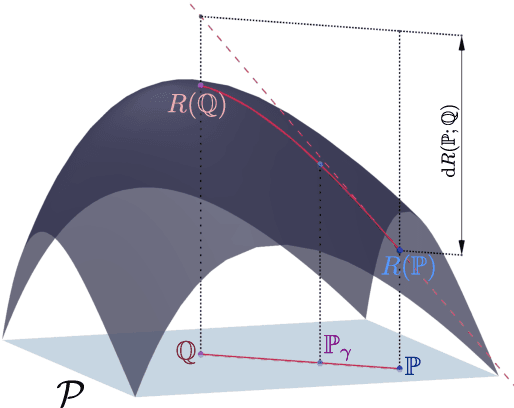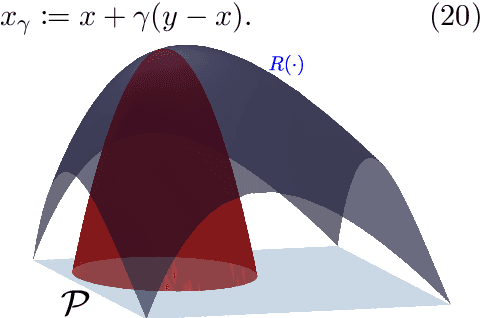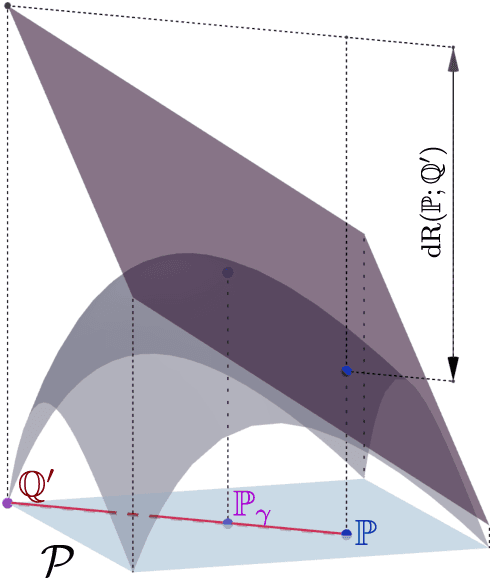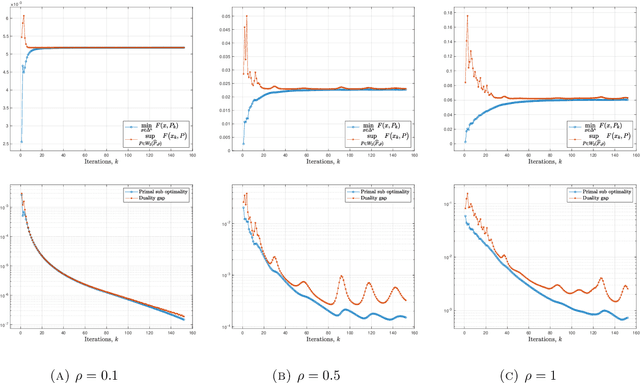Peyman Mohajerin Esfahani
Rank-One Modified Value Iteration
May 03, 2025Abstract:In this paper, we provide a novel algorithm for solving planning and learning problems of Markov decision processes. The proposed algorithm follows a policy iteration-type update by using a rank-one approximation of the transition probability matrix in the policy evaluation step. This rank-one approximation is closely related to the stationary distribution of the corresponding transition probability matrix, which is approximated using the power method. We provide theoretical guarantees for the convergence of the proposed algorithm to optimal (action-)value function with the same rate and computational complexity as the value iteration algorithm in the planning problem and as the Q-learning algorithm in the learning problem. Through our extensive numerical simulations, however, we show that the proposed algorithm consistently outperforms first-order algorithms and their accelerated versions for both planning and learning problems.
Optimal Bayesian Affine Estimator and Active Learning for the Wiener Model
Apr 07, 2025Abstract:This paper presents a Bayesian estimation framework for Wiener models, focusing on learning nonlinear output functions under known linear state dynamics. We derive a closed-form optimal affine estimator for the unknown parameters, characterized by the so-called "dynamic basis statistics (DBS)." Several features of the proposed estimator are studied, including Bayesian unbiasedness, closed-form posterior statistics, error monotonicity in trajectory length, and consistency condition (also known as persistent excitation). In the special case of Fourier basis functions, we demonstrate that the closed-form description is computationally available, as the Fourier DBS enjoys explicit expression. Furthermore, we identify an inherent inconsistency in single-trajectory measurements, regardless of input excitation. Leveraging the closed-form estimation error, we develop an active learning algorithm synthesizing input signals to minimize estimation error. Numerical experiments validate the efficacy of our approach, showing significant improvements over traditional regularized least-squares methods.
Offline Reinforcement Learning via Inverse Optimization
Feb 27, 2025Abstract:Inspired by the recent successes of Inverse Optimization (IO) across various application domains, we propose a novel offline Reinforcement Learning (ORL) algorithm for continuous state and action spaces, leveraging the convex loss function called ``sub-optimality loss" from the IO literature. To mitigate the distribution shift commonly observed in ORL problems, we further employ a robust and non-causal Model Predictive Control (MPC) expert steering a nominal model of the dynamics using in-hindsight information stemming from the model mismatch. Unlike the existing literature, our robust MPC expert enjoys an exact and tractable convex reformulation. In the second part of this study, we show that the IO hypothesis class, trained by the proposed convex loss function, enjoys ample expressiveness and achieves competitive performance comparing with the state-of-the-art (SOTA) methods in the low-data regime of the MuJoCo benchmark while utilizing three orders of magnitude fewer parameters, thereby requiring significantly fewer computational resources. To facilitate the reproducibility of our results, we provide an open-source package implementing the proposed algorithms and the experiments.
Scalable Kernel Inverse Optimization
Oct 31, 2024



Abstract:Inverse Optimization (IO) is a framework for learning the unknown objective function of an expert decision-maker from a past dataset. In this paper, we extend the hypothesis class of IO objective functions to a reproducing kernel Hilbert space (RKHS), thereby enhancing feature representation to an infinite-dimensional space. We demonstrate that a variant of the representer theorem holds for a specific training loss, allowing the reformulation of the problem as a finite-dimensional convex optimization program. To address scalability issues commonly associated with kernel methods, we propose the Sequential Selection Optimization (SSO) algorithm to efficiently train the proposed Kernel Inverse Optimization (KIO) model. Finally, we validate the generalization capabilities of the proposed KIO model and the effectiveness of the SSO algorithm through learning-from-demonstration tasks on the MuJoCo benchmark.
Variance-Reduced Cascade Q-learning: Algorithms and Sample Complexity
Aug 13, 2024Abstract:We study the problem of estimating the optimal Q-function of $\gamma$-discounted Markov decision processes (MDPs) under the synchronous setting, where independent samples for all state-action pairs are drawn from a generative model at each iteration. We introduce and analyze a novel model-free algorithm called Variance-Reduced Cascade Q-learning (VRCQ). VRCQ comprises two key building blocks: (i) the established direct variance reduction technique and (ii) our proposed variance reduction scheme, Cascade Q-learning. By leveraging these techniques, VRCQ provides superior guarantees in the $\ell_\infty$-norm compared with the existing model-free stochastic approximation-type algorithms. Specifically, we demonstrate that VRCQ is minimax optimal. Additionally, when the action set is a singleton (so that the Q-learning problem reduces to policy evaluation), it achieves non-asymptotic instance optimality while requiring the minimum number of samples theoretically possible. Our theoretical results and their practical implications are supported by numerical experiments.
From Optimization to Control: Quasi Policy Iteration
Nov 18, 2023



Abstract:Recent control algorithms for Markov decision processes (MDPs) have been designed using an implicit analogy with well-established optimization algorithms. In this paper, we make this analogy explicit across four problem classes with a unified solution characterization. This novel framework, in turn, allows for a systematic transformation of algorithms from one domain to the other. In particular, we identify equivalent optimization and control algorithms that have already been pointed out in the existing literature, but mostly in a scattered way. With this unifying framework in mind, we then exploit two linear structural constraints specific to MDPs for approximating the Hessian in a second-order-type algorithm from optimization, namely, Anderson mixing. This leads to a novel first-order control algorithm that modifies the standard value iteration (VI) algorithm by incorporating two new directions and adaptive step sizes. While the proposed algorithm, coined as quasi-policy iteration, has the same computational complexity as VI, it interestingly exhibits an empirical convergence behavior similar to policy iteration with a very low sensitivity to the discount factor.
Inverse Optimization for Routing Problems
Jul 14, 2023



Abstract:We propose a method for learning decision-makers' behavior in routing problems using Inverse Optimization (IO). The IO framework falls into the supervised learning category and builds on the premise that the target behavior is an optimizer of an unknown cost function. This cost function is to be learned through historical data, and in the context of routing problems, can be interpreted as the routing preferences of the decision-makers. In this view, the main contributions of this study are to propose an IO methodology with a hypothesis function, loss function, and stochastic first-order algorithm tailored to routing problems. We further test our IO approach in the Amazon Last Mile Routing Research Challenge, where the goal is to learn models that replicate the routing preferences of human drivers, using thousands of real-world routing examples. Our final IO-learned routing model achieves a score that ranks 2nd compared with the 48 models that qualified for the final round of the challenge. Our results showcase the flexibility and real-world potential of the proposed IO methodology to learn from decision-makers' decisions in routing problems.
Nonlinear Distributionally Robust Optimization
Jun 05, 2023



Abstract:This article focuses on a class of distributionally robust optimization (DRO) problems where, unlike the growing body of the literature, the objective function is potentially non-linear in the distribution. Existing methods to optimize nonlinear functions in probability space use the Frechet derivatives, which present both theoretical and computational challenges. Motivated by this, we propose an alternative notion for the derivative and corresponding smoothness based on Gateaux (G)-derivative for generic risk measures. These concepts are explained via three running risk measure examples of variance, entropic risk, and risk on finite support sets. We then propose a G-derivative based Frank-Wolfe~(FW) algorithm for generic non-linear optimization problems in probability spaces and establish its convergence under the proposed notion of smoothness in a completely norm-independent manner. We use the set-up of the FW algorithm to devise a methodology to compute a saddle point of the non-linear DRO problem. Finally, for the minimum variance portfolio selection problem we analyze the regularity conditions and compute the FW-oracle in various settings, and validate the theoretical results numerically.
Learning in Inverse Optimization: Incenter Cost, Augmented Suboptimality Loss, and Algorithms
May 12, 2023



Abstract:In Inverse Optimization (IO), an expert agent solves an optimization problem parametric in an exogenous signal. From a learning perspective, the goal is to learn the expert's cost function given a dataset of signals and corresponding optimal actions. Motivated by the geometry of the IO set of consistent cost vectors, we introduce the "incenter" concept, a new notion akin to circumcenter recently proposed by Besbes et al. [2022]. Discussing the geometric and robustness interpretation of the incenter cost vector, we develop corresponding tractable convex reformulations, which are in contrast with the circumcenter, which we show is equivalent to an intractable optimization program. We further propose a novel loss function called Augmented Suboptimality Loss (ASL), as a relaxation of the incenter concept, for problems with inconsistent data. Exploiting the structure of the ASL, we propose a novel first-order algorithm, which we name Stochastic Approximate Mirror Descent. This algorithm combines stochastic and approximate subgradient evaluations, together with mirror descent update steps, which is provably efficient for the IO problems with high cardinality discrete feasible sets. We implement the IO approaches developed in this paper as a Python package called InvOpt. All of our numerical experiments are reproducible, and the underlying source code is available as examples in the InvOpt package.
Fast Algorithm for Constrained Linear Inverse Problems
Dec 06, 2022Abstract:We consider the constrained Linear Inverse Problem (LIP), where a certain atomic norm (like the $\ell_1 $ and the Nuclear norm) is minimized subject to a quadratic constraint. Typically, such cost functions are non-differentiable which makes them not amenable to the fast optimization methods existing in practice. We propose two equivalent reformulations of the constrained LIP with improved convex regularity: (i) a smooth convex minimization problem, and (ii) a strongly convex min-max problem. These problems could be solved by applying existing acceleration based convex optimization methods which provide better $ O \big( \frac{1}{k^2} \big) $ theoretical convergence guarantee. However, to fully exploit the utility of these reformulations, we also provide a novel algorithm, to which we refer as the Fast Linear Inverse Problem Solver (FLIPS), that is tailored to solve the reformulation of the LIP. We demonstrate the performance of FLIPS on the sparse coding problem arising in image processing tasks. In this setting, we observe that FLIPS consistently outperforms the Chambolle-Pock and C-SALSA algorithms--two of the current best methods in the literature.
 Add to Chrome
Add to Chrome Add to Firefox
Add to Firefox Add to Edge
Add to Edge